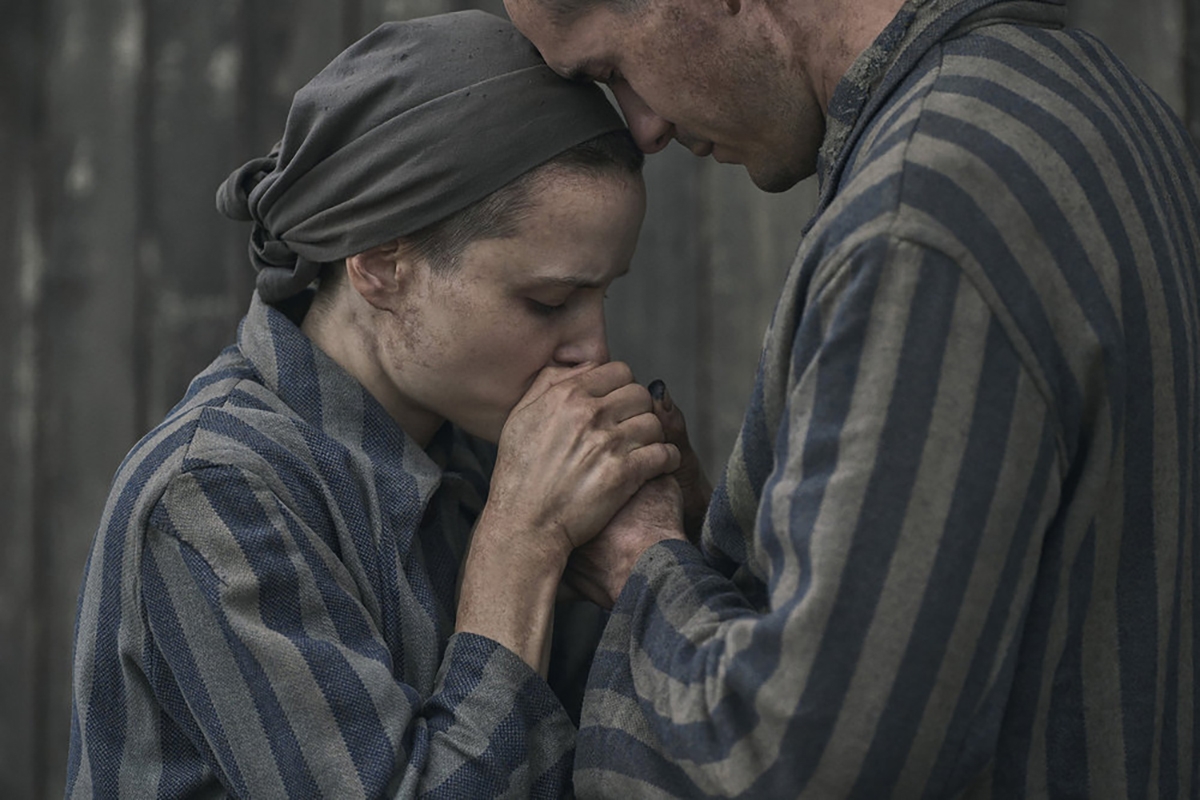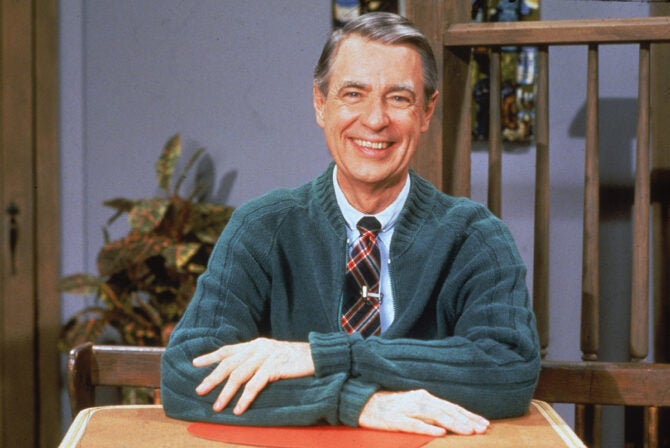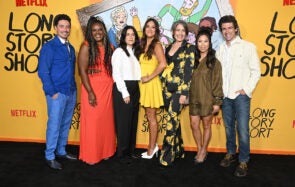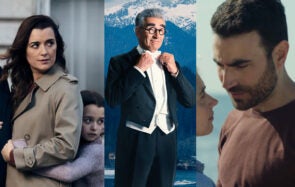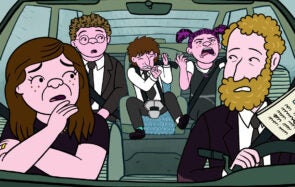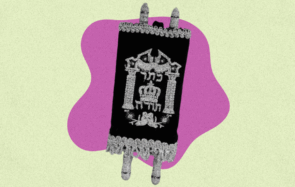On the Thursday before Passover, I found myself at the Museum of Jewish Heritage in New York, moderating a panel about “The Tattooist of Auschwitz,” whose six episodes just premiered on Peacock.
If you’ve never been to the Museum of Jewish Heritage, it is quite a magnificent structure standing at the edge of Manhattan, overlooking the Hudson River in Battery Park. It’s a stunningly beautiful, quite stately building, whose mission is to enshrine the memory of the biggest mass killing of Jews in history, the Holocaust, in a city that vibrates with so much Jewish life.
And that’s what I and my fellow panelists — executive producer Claire Mundell, director Tali Shalom-Ezer, star Jonah Hauer King and museum director Jack Kliger — were there to do, too: to enshrine the memory of the Holocaust through this particular star-studded show, an adaptation of a novel that has sold 12 million copies worldwide, which tells the story of one man, Lali Sokolov, but also the story of all the people who touched him in Auschwitz, including the woman who became his wife, Gita Furman. The series also tells the story of the titular concentration camp — one that has been the feature of many shows and movies before, but that in this show, viewers experience in a horrific, detailed way. Sokolov spent three years in the camp, and arguably a part of him stayed there for the rest of his life, and five of the show’s harrowing episodes take place in its barracks.
Heather Morris, the author of the book, was there at the museum in a glittery blouse, her lips painted red, teeming with excitement. She was sweet and kind, and told me how moved she was by watching the show, especially the finale. There has been criticism about Morris’ book, including the accuracy of some of its retellings, which the creators of the show took to heart when working on this project. They enlisted Naomi Gryn as a consultant of history, and they addressed specific pain points — from the number on Gita’s arm, to the use of penicillin in the book which didn’t exist at the time, to even Lali’s name, which originally was Lale in the bestselling novel. Yet I’d actually argue that the most important way they addressed these critiques was by touching on the fallibility of memory itself, especially in times of trauma.
In the show, we get to see Lali in the present day, whereas in the book we only see him in Auschwitz. In his role as the older Lali, Harvey Keitel plays a man haunted by the memories of his time there, but also unable to recognize which of those memories are real and which may have been changed in his head over the years. That haunting is quite literal, with the ghosts of his past appearing to him as he tells his story to an overly earnest Morris, played by Melanie Lynskey. Now that I have met the author ever so briefly, I can confirm Lynskey channels a younger and more innocent version of Morris wonderfully — a first time author and young mother trying to navigate the heaviness of both bearing witness and trying to retell this complicated story.
The event was the first public screening of the show in the U.S., and the choice of location belied an amount of special care — here is a uniquely Jewish story, though written by a non-Jewish author (a fact the show acknowledges early on) being shared for the first time on these shores in a very specifically Jewish space, with a very specifically Jewish audience, with even specifically Jewish fancy appetizers (they were delicious).
The first episode, which I had already watched twice, hit me harder as it was screened in this room full of a rapt Jewish audience as I heard the sniffles and gasps from my fellow viewers. Every episode features a still of the victims as they look into the eyes of the viewer, trying to consecrate their memory for the viewer in a powerful, mournful moment.
One scene in the first episode had everyone in the crowd reeling: when we see young Lali say goodbye to his mother as he boards the train to Auschwitz, and then an older Lali crying as he thinks of her, imagining what he would’ve told her if only he could. It’s a moment that hits home personally for me, as I remembered my own great-grandmother, herself a survivor, talking to her mother, grieving her afresh, in her last days and months of life.
It was hard to take the stage after that, like it was hard when I visited Auschwitz on a school trip as a teen and then had to sit and eat and laugh with my classmates in the evening. Yet we rallied, took a deep centering breath, and held our panel discussion, which ended up being wonderful, illuminating, and cementing the kind of reverence with which the team behind this show treated its subject matter. Mundell talked about how statistics around Holocaust education in the U.S. made her want to get this bestselling book in front of even more people. Ezer Shalom spoke of her own family’s connection to the Holocaust, and the stories of those relatives of hers who perished that she will never know. Hauer King shared his deep connection to Lali and his story, informed by his own family history (his grandfather left Poland before WWII). Kliger seamlessly connected the show to the work the museum is doing.
In many ways, “The Tattooist of Auschwitz” gets tougher to watch as the episodes go on, but it also finds moments of respite in the darkest places, too, especially through the eyes of an ever optimistic and in love Gita. And while the show is respectful of Jewish tradition, it treats the other victims of Auschwitz with similar reverence — showing Roma families and gay prisoners at the camp. During the panel, Ezer Shalom and Mundell said that when it came to authentic casting, there were a lot of Jewish members of the cast, but they also felt that it was important to represent how diverse the locations and backgrounds of the prisoners of Auschwitz were.
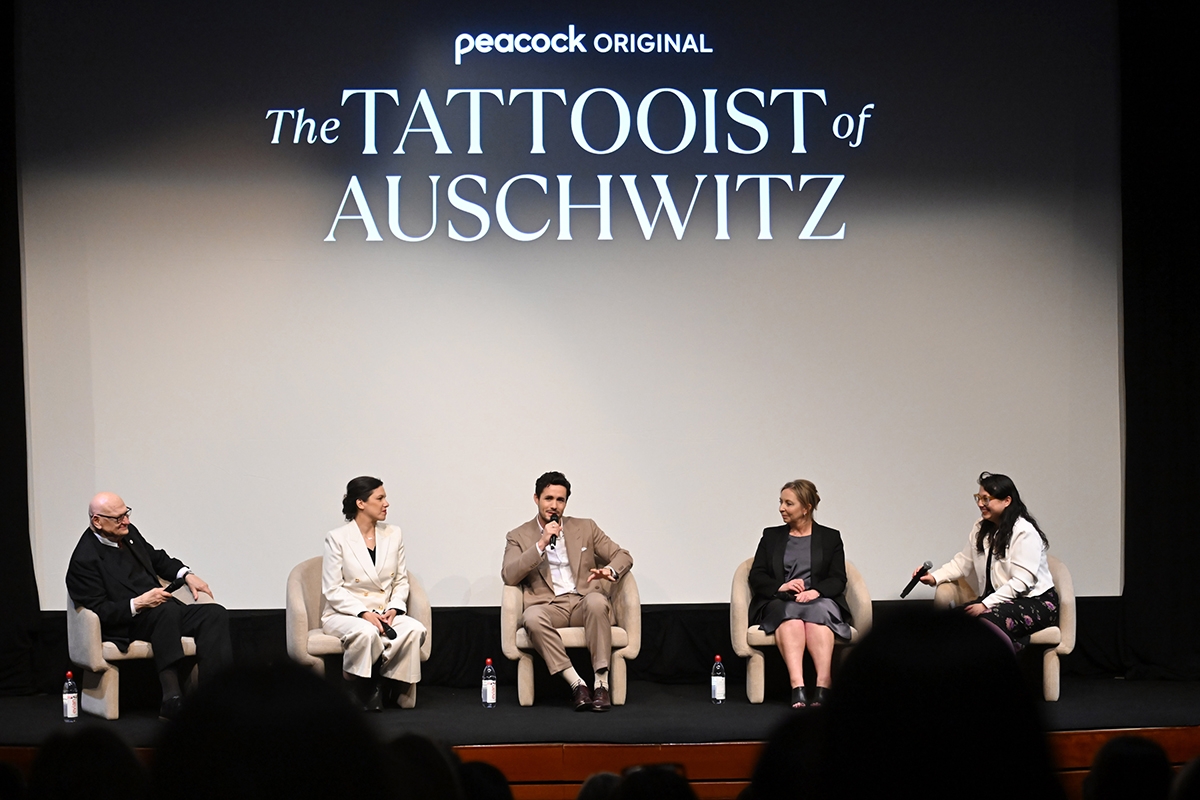
THE TATTOOIST OF AUSCHWITZ — “The Tattooist of Auschwitz NYC Screening” — Pictured: (l-r) Jack Kliger, President & CEO, Museum of Jewish Heritage/Panelist; Tali Shalom-Ezer, Director, Co-Executive Producer; Jonah Hauer-King; Claire Mundell, Executive Producer; Lior Zaltzman, Kveller Deputy Managing Editor/Panel Moderator at the Museum of Jewish Heritage on April 18, 2024 — (Photo by: Noam Galai/Peacock)
At its core, “The Tattooist of Auschwitz” is a love story. In the final episode, we even get to see a Jewish wedding, held under the chuppah. Inspired by this contrast of Jewish life and the darkest aspects of our history, I ended the Q&A on stage with some Jewish joy, too. I asked for everyone to share a moving, joyful Jewish moment in their lives. Hauer King made us all laugh with a story about trying to get recruited to act in a “Little Mermaid” based Purim spiel. Shalom-Ezer shared the sweetness of the bite of her grandmother’s haroset. Mundell, who is Scottish and not Jewish, shared her fondest memory from the set of the show — a seder they held while shooting, singing songs, reading the haggadah, eating matzah and sampling roasted eggs for the first time. Kliger shared a delightful anectdote about how the Holocaust survivors he works with make him laugh.
The show shows this kind of contrast in Lali, too — his humor, his humanity and his pain, through both Hauer King and Keitel’s passionate performances. It also shows how tortured he was by what he had to do to survive, and it’s that aspect that drew Shalom-Ezer to the project. “Something really connected me to Lali and to his experience — to his guilt. Of course, Lali is aware that he’s the victim. But the fact that it was at a twist, and he was part of the Nazi system, made him feel very, very ashamed for everything that he was forced to do. Something about this complexity really attracted me to the story.”
The end of the show features a video testimony of the real-life Lali, marrying this somewhat fictionalized story with the person behind it. Gary Sokolov, Lali’s son, watched the entire series with and he ultimately gave the show his blessing, emotional to see his father brought to life.
“The Tattooist of Auschwitz” is also an incredibly graphic show. It shows bodies and senseless violence of every kind. It’s something that, as a viewer, I often struggle with, and it’s a question that I posed to Mundell: How do you decide how much to show, how graphic to be, and yet take care of the audience’s psyche, too?
“The question of tone is a key consideration, and something we’ve spoken about from the very beginning of the process,” Mundell said. “I think that we have to confront the audience with some sense of all the atrocities that happened there. Although, of course, one can never [actually] depict that in drama. It’s almost indescribable. All we can do is try to give a sense of it. At the same time, we want people to watch the whole show, because we want them to get our final message.”
For Mundell and the team behind the show, it was about balancing the ever-present trauma with a joy of life. It was about “coming back to old Lali on the sofa and seeing that he is this 80-year-old man, who, in spite of everything that was done to him, and in spite of the trauma that is very real for him and continues to haunt him, is also someone who loves life, who is a flirt, who enjoys having a good time and having fun with Heather, in spite of the fact that his wife has recently deceased. It was important to be able to show the humanity of the real person and the fact that even though the camp was liberated, their lives continued to be super complex because they were traumatized.
“But at the same time,” Mundell added, “they had such a pure understanding of the sanctity of life and living, and the importance of loving life to the fullest.” Ultimately, she tried to show that “people, in spite of the process of dehumanization, tried to hold on to their humanity by continuing to live in the face of this death camp.”
When we all left the theater, many of us ascended upstairs to where we could drink and find Jewish joy and noshes among each other. There were reminders there, too, of Jewish suffering, including the more recent variety — dog tags for hostages, yellow ribbons and the echoes of the show reliving in our minds. To mix joy and sadness, laughter with great pain, there was something so very Jewish in that.
